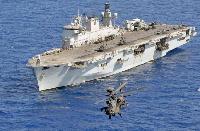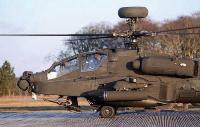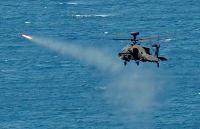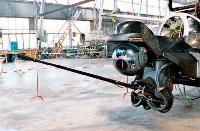Фотографии
-
Russian Air Force Army Aviation Branch Hinds firing unguided S-8 rockets at Dorogobuzh in October 2011.
Самолёты на фотографии: Миль Ми-24 / Ми-35 - Россия - 1969
-
Russian Air Force Army Aviation Branch crew load S-8 rockets into launchers on a Mi-24 Hind at Vyazma AB in October 2011.
Самолёты на фотографии: Миль Ми-24 / Ми-35 - Россия - 1969
-
The pilot's cockpit of the ATE Super Hind Mk III is dominated by a new head-up display.
Самолёты на фотографии: Миль Ми-24 / Ми-35 - Россия - 1969
-
Russian Air Force Army Aviation Branch Mi-24 Hinds at Monchegosk AB in September 2012.
Самолёты на фотографии: Миль Ми-24П / Ми-35П - Россия - 1974
-
Регистрационный номер: RF-94965 Mi-24P Hind RF-94965/08 red at Krymsk AFB in December 2011. The helicopter is armed with a pair of B-8 20-round rocket launchers, two P-50T training bombs, four SACLOS 9K114 Shturm anti-tank missiles and one Gryazev-Shipunov GSh-30-2K twin-barrel 30mm cannon.
Самолёты на фотографии: Миль Ми-24П / Ми-35П - Россия - 1974
-
A line of Hinds at Monchegosk AB during in September 2012.
Самолёты на фотографии: Миль Ми-24П / Ми-35П - Россия - 1974
-
Самолёты на фотографии: Миль Ми-24П / Ми-35П - Россия - 1974
-
Belarusian Mi-24P Hinds over Machulishchi AFB.
Самолёты на фотографии: Миль Ми-24П / Ми-35П - Россия - 1974
-
Регистрационный номер: RF-93635 Самолёты на фотографии: Миль Ми-24П / Ми-35П - Россия - 1974
-
Самолёты на фотографии: Миль Ми-24П / Ми-35П - Россия - 1974
-
The first two T129A Atak helicopters delivered to the KKK were BG1001 and BG1002.
Самолёты на фотографии: Agusta A-129 Mangusta - Италия - 1983
-
T129 prototype P6 was the first to be built by TAI and made its maiden flight on August 17, 2011.
Самолёты на фотографии: Agusta A-129 Mangusta - Италия - 1983
-
Заказ Турцией 60-и вертолетов Mangusta придал программе новый импульс. Вертолеты предназначены для замены в армии Турции устаревших AH-1P и AH-1W SuperCobra. T129 окрашиваются по трехцветной камуфляжной схеме, близкой к схеме окраски австралийских Eurocopter Tiger.
T129As BG1001 and BG1002 are shown carrying two 19-round pods for 70mm unguided rockets on a pre-delivery test flight from TAI's flight test centre at Akinci near Ankara.Самолёты на фотографии: Agusta A-129 Mangusta - Италия - 1983
-
Ground crew watch as TAI test pilots prepare to depart from Akinci for a test sortie. The two aircraft shown, BG1001 and BG1002, were delivered to the KKK in the EDH configuration.
Самолёты на фотографии: Agusta A-129 Mangusta - Италия - 1983
-
A Royal Air Force Chinook and Army Air Corps Apache AH1 onboard HMS Illustrious.
Самолёты на фотографии: Boeing-Vertol CH-47 Chinook - США - 1961McDonnell Douglas AH-64D Apache Longbow - США - 1991
-
The Rooivalk can comfortably fly backwards and can reach sideways speeds of 50 knots (93km/h).
Самолёты на фотографии: Denel CSH-2 Rooivalk - ЮАР - 1990
-
A Rooivalk fires a Mokopa anti-tank missile during a test flight. The Rooivalk can carry up to 16 Mokopas on the inner two pylons of each stub wing. Although the Rooivalk is cleared to fire the Mokopa, the SAAF has yet to buy any of the missiles.
Самолёты на фотографии: Denel CSH-2 Rooivalk - ЮАР - 1990
-
Самолёты на фотографии: Denel CSH-2 Rooivalk - ЮАР - 1990
-
The Denel Rooivalk is the only attack helicopter to be designed and built in Africa.
Самолёты на фотографии: Denel CSH-2 Rooivalk - ЮАР - 1990
-
The South African Air Force operates 11 Rooivalks which are assigned to 16 Squadron, based at Bloemspruit Air Force Base near Bloemfontein in the Free State. Deliveries began on January 6,1999.
Самолёты на фотографии: Denel CSH-2 Rooivalk - ЮАР - 1990
-
Самолёты на фотографии: Denel CSH-2 Rooivalk - ЮАР - 1990
-
Самолёты на фотографии: Denel CSH-2 Rooivalk - ЮАР - 1990
-
Самолёты на фотографии: Denel CSH-2 Rooivalk - ЮАР - 1990
-
The pilot sits above and behind the weapons system officer in a separate aft cockpit. Both environmentally controlled cockpits are interchangeable and have dual flight controls, which includes hands on collective and stick.
Самолёты на фотографии: Denel CSH-2 Rooivalk - ЮАР - 1990
-
The Rooivalk's front cockpit is dominated by two 160 x 160mm (6.3 x 6.3 inch) liquid crystal colour multifunction displays.
Самолёты на фотографии: Denel CSH-2 Rooivalk - ЮАР - 1990
-
An Apache AH1 takes off from the flight deck of HMS Ark Royal during an exercise off the Cornish coast.
Самолёты на фотографии: McDonnell Douglas AH-64D Apache Longbow - США - 1991
-
Самолёты на фотографии: McDonnell Douglas AH-64D Apache Longbow - США - 1991
-
Самолёты на фотографии: McDonnell Douglas AH-64D Apache Longbow - США - 1991
-
An Apache AH1 being lifted from the hangar to the flight deck onboard HMS Illustrious.
Самолёты на фотографии: McDonnell Douglas AH-64D Apache Longbow - США - 1991
-
The M-TADS electro-optical fire control system is fitted on the nose of the Apache and the Longbow FCR is positioned above the rotor hub.
Самолёты на фотографии: McDonnell Douglas AH-64D Apache Longbow - США - 1991
-
Самолёты на фотографии: McDonnell Douglas AH-64D Apache Longbow - США - 1991
-
An Apache AH1 loaded with three inert AGM-114 Hellfire anti-tank missiles carried on a M272 launcher.
Самолёты на фотографии: McDonnell Douglas AH-64D Apache Longbow - США - 1991
-
Army Air Corps personnel from No.656 Squadron reload the 30mm M230 chain qun automatic cannon onboard an Apache AH1.
Самолёты на фотографии: McDonnell Douglas AH-64D Apache Longbow - США - 1991
-
Вертолет "Апач" уходит на боевое задание, лето 2011г.
An Army Air Corps Apache AH1 takes off from HMS Ocean during Operation Ellamy.Самолёты на фотографии: McDonnell Douglas AH-64D Apache Longbow - США - 1991
-
Регистрационный номер: ZJ203 Apache AH1 ZJ203 seen at a forward arming and refuelling point on the Salisbury Plain Training Area.
Самолёты на фотографии: McDonnell Douglas AH-64D Apache Longbow - США - 1991
-
HIDAS utilises multi-spectral sensors. This shot shows two such sensors, one on each side of the Apache's forward fuselage.
Самолёты на фотографии: McDonnell Douglas AH-64D Apache Longbow - США - 1991
-
An Apache AH1 flown by No.656 Squadron Army Air Corps fires a Hellfire missile during an exercise conducted from HMS Ocean.
Самолёты на фотографии: McDonnell Douglas AH-64D Apache Longbow - США - 1991
-
Tarqetinq a pro-Gaddafi truck with an AGM-114 Hellfire missile.
Самолёты на фотографии: McDonnell Douglas AH-64D Apache Longbow - США - 1991
-
Самолёты на фотографии: Миль Ми-35М - Россия - 1995
-
The first production-standard Mi-35Ms were delivered to Venezuela's Army Aviation Service.
Самолёты на фотографии: Миль Ми-35М - Россия - 1995
-
The Brazilian Air Force was the second export customer for the enhanced Mi-35M. Nine of the 12 Mi-35Ms ordered by Brazil have been delivered so far, the final three will follow in 2013.
Самолёты на фотографии: Миль Ми-35М - Россия - 1995
-
The Mi-35M front cockpit is dominated by a display for the electro-optical sensor used by the weapon system officer for targeting using the bulky hand controller shown.
Самолёты на фотографии: Миль Ми-35М - Россия - 1995
-
The Mi-35M pilot's cockpit was upgraded with a pair of LCD displays of the KNEI-24 digital avionic package for displaying flight, navigation and targeting information.
Самолёты на фотографии: Миль Ми-35М - Россия - 1995
-
Advanced Technologies and Engineering of South Africa undertook the most successful Hind upgrade programme outside Russia so far. An export order covering as many as 40 Mi-24s was signed in 1999, and the first upgraded helicopters dubbed Super Hinds were supplied to Algeria in the same year.
Самолёты на фотографии: ATE Super Hind - ЮАР - 1999
-
The Super Hind's Argos 550 gyro-stabilised multi-sensor payload with auto-tracker, TV-camera, FLIR and the F2 20mm cannon.
Самолёты на фотографии: ATE Super Hind - ЮАР - 1999
Статьи
- Attack helicopters (2)
- News
- C.Kjelgaard - 787. Dream or Nightmare? /Commercial/
- D.Isby - Stealth Struggles /Military/
- D.Sloggett - The Dragon Gains its Strategic Wings /Military/
- I.Harding - Voyager's Journey... so far /Military/
- J.Kraak - Operation Serval /Military/
- K.Grozev, A.Mladenov - Covert Affair /Military/












































